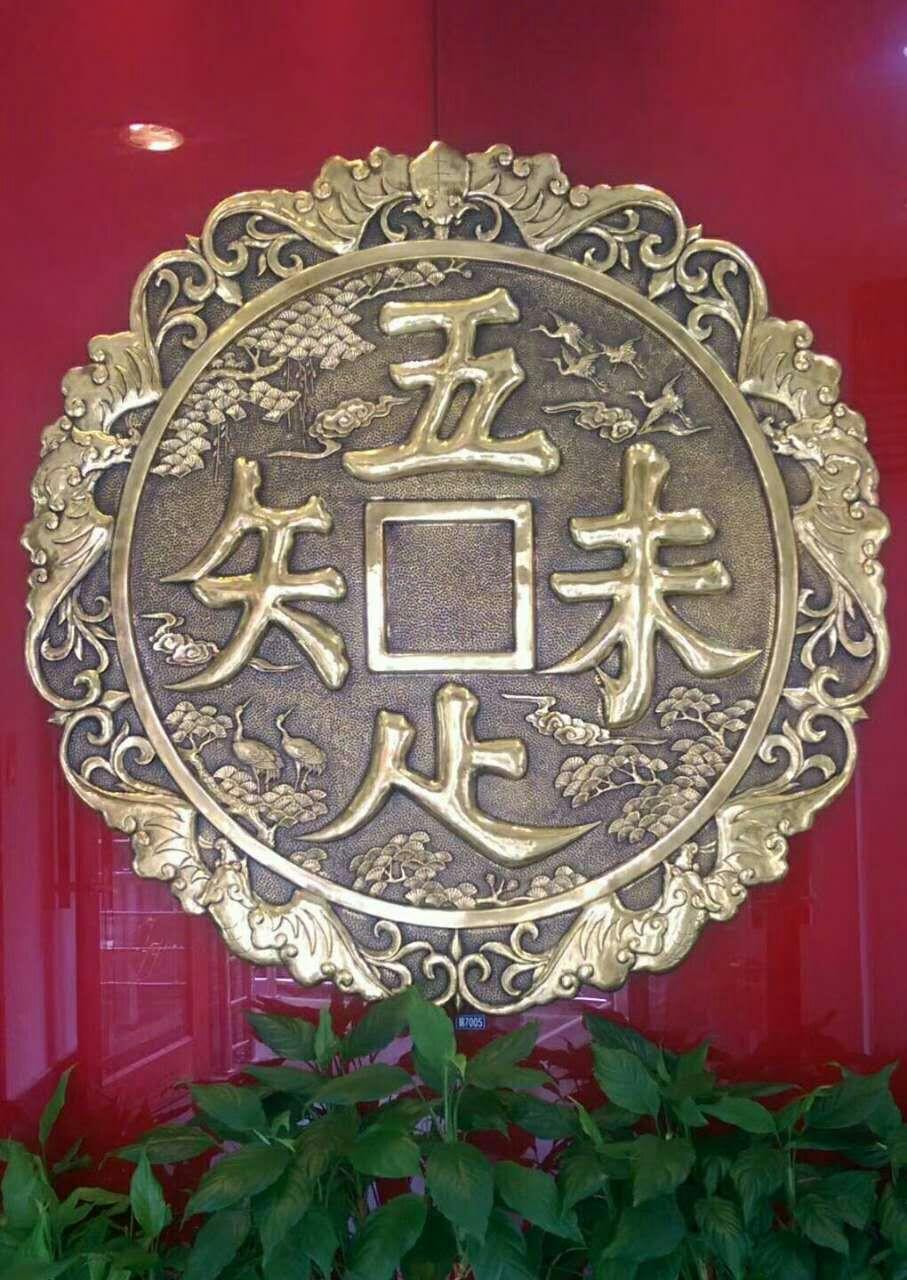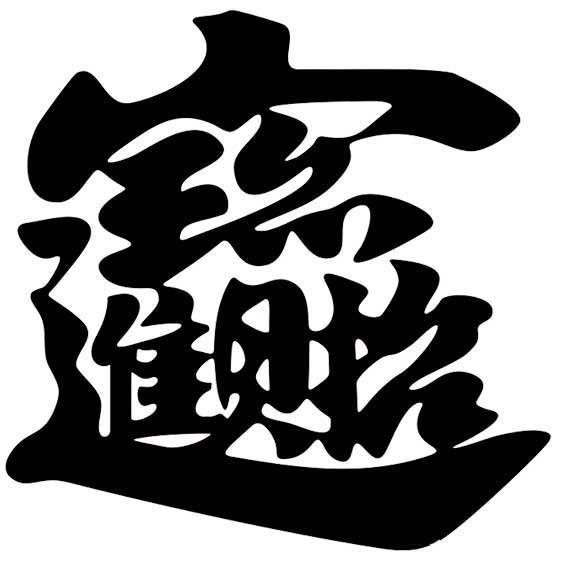A polysyllabic character that can be read in two different ways
« previous post | next post »
Photo taken in Hangzhou by Nikita Kuzmin's Chinese teacher:
This can be read either as:
wúwèi zhīzú 吾味知足 ("I / my flavor know / feel sufficient / content")
or as:
wǔwèi zhīzú 五味知足 ("five flavors know / feel sufficient / content")
It seems as though the Chinese are having a lot of fun with this quadrisyllabic, disemous character, as is evident from this blog post and this online user forum.
The native speakers of Chinese whom I approached for their opinions about this character are pretty much evenly divided on which of the two readings they think is better, though there seems to be a slight preference for the latter: wǔwèi zhīzú 五味知足 ("five flavors know / feel sufficient / content").
Three respondents remarked thus:
1.
My first reaction is that wǔwèi zhīzú 五味知足 ("five flavors know / feel sufficient / content") makes more sense to me since it's related to food. Wǔwèi 五味 ("five flavors") might refer to the five flavors: suān tián kǔ là xián 酸甜苦辣咸 ("sour sweet bitter hot / spicy salty"). When you can taste all five, it means you are eating something special (in a good way). Wúwèi zhīzú 吾味知足 ("I / my flavor know / feel sufficient / content") sounds a little bit strange to me. But it also makes sense. I interpret it as "I am satisfied with my taste / the things that I am tasting". But once I think about it more, it also fits the restaurant theme because when I am satisfied with the things I am tasting, I must be happy with the restaurant.
2.
I just realized why I naturally think wǔwèi zhīzú 五味知足 ("five flavors know / feel sufficient / content") sounds more common than wúwèi zhīzú 吾味知足 ("I / my flavor know / feel sufficient / content").
Somehow I am more familiar with the sequence of wǔwèi zhīzú 五味知足 ("five flavors know / feel sufficient / content"), meaning wǔ zhǒng wèidào (wǒ) dōu zhīdàole 五种味道(我)都知道了 ("[as for] the five kinds of flavors, [I] know all of them").
However, wúwèi zhīzú 吾味知足 ("I / my flavor know / feel sufficient / content") literally means wǒ chī de wèidào, wǒ hěn zhīzú / wǒ quánbù zhīdàole 我吃的味道,我很知足/我全部知道了 ("of the flavors I've eaten, I know them sufficiently / I know them completely"). (This is the sequence of Chinese sentences. But now my Chinese grammar is broken and I think the opposite way.) It's very interesting for me to reflect on this.
3.
I feel like wúwèi zhīzú 吾味知足 ("I / my flavor know / feel sufficient / content") makes more sense to me in terms of the visual pattern: every character around the outside borrows the "口" in the middle.
If anyone wants to observe an elaborate polysyllabic Chinese character in the wild and happens to be near the University of Pennsylvania, go over to the Han Dynasty restaurant at 3711 Market Street and you will see a version of this at the front desk:
That is read zhāocáijìnbǎo 招財進寶 ("bring / usher in wealth and riches").
Some earlier posts on polysyllabic characters:
- "Polysyllabic characters in Chinese writing " (8/2/11)
- "Polysyllabic characters revisited " (6/18/15)
- "A new polysyllabic character" (4/3/16)
- "Yet another polysyllabic Chinese character" (10/31/16)
[Thanks to Yixue Yang, Jinyi Cai, and Fangyi Cheng]


J Greely said,
October 10, 2017 @ 3:37 pm
My shodō teacher taught us the Zen expression 吾唯足知 that shows up frequently on coins and water basins (and at least one brand of shōchū…), but in that case it's read clockwise (ware tada taru wo shiru).
Interestingly, an image search for "吾味知足" turns up plenty of samples of "吾唯足知" (as well as other expressios where the 口 is not part of any of the four characters), but a search for "吾味足知" returns nothing.
-j
Ellen K. said,
October 10, 2017 @ 6:46 pm
What does "disemous" mean?
Ellen K. said,
October 10, 2017 @ 6:59 pm
Nevermind… I figured it out after running into the term polysemous and extrapolating from there.
Matt said,
October 10, 2017 @ 9:41 pm
My shodō teacher taught us the Zen expression 吾唯足知 that shows up frequently on coins and water basins (and at least one brand of shōchū…), but in that case it's read clockwise (ware tada taru wo shiru).
Ah, but is it really? The famous water basin at Ryoanji has, clockwise from the top, 吾唯足知, but if it's supposed to be proper Chinese rather than the dreaded hentai kanbun, then the last two syllables must appear in the opposite order (written 知足… but still pronounced "taru o shiru" if read kundoku-style).
Meanwhile, Baidu prefers the order 唯吾知足, thus "Only I know sufficiency" (adjust with favored translation of 知足 as desired) rather than "I only know sufficiency." Seems a bit boastful that way…
Incidentally, it seems to me that it's worth distinguishing between polysyllabic characters proper (like the one-character version of 図書館) and playfully written sentences like this.
J Greely said,
October 11, 2017 @ 1:40 pm
Ah, but is it really?
If you go by the relative prevalence on amazon.co.jp and Google/Bing searches restricted to Japanese results, yes, it is "吾唯足知". They (and I) may all be "Internet wrong", of course; Tsumura-sensei never wrote it out for us as just the 4 characters without the visual pun, and none of my dead-tree references includes many yojijukugo.
The Japanese wikipedia page for Ryoanji describes the original basin in clockwise order and maps it to "吾れ唯だ足ることを知る", but captions the image "知足の蹲踞". I'm willing to believe that the modern explanation has become more popular than the intended reading order, especially online.
-j